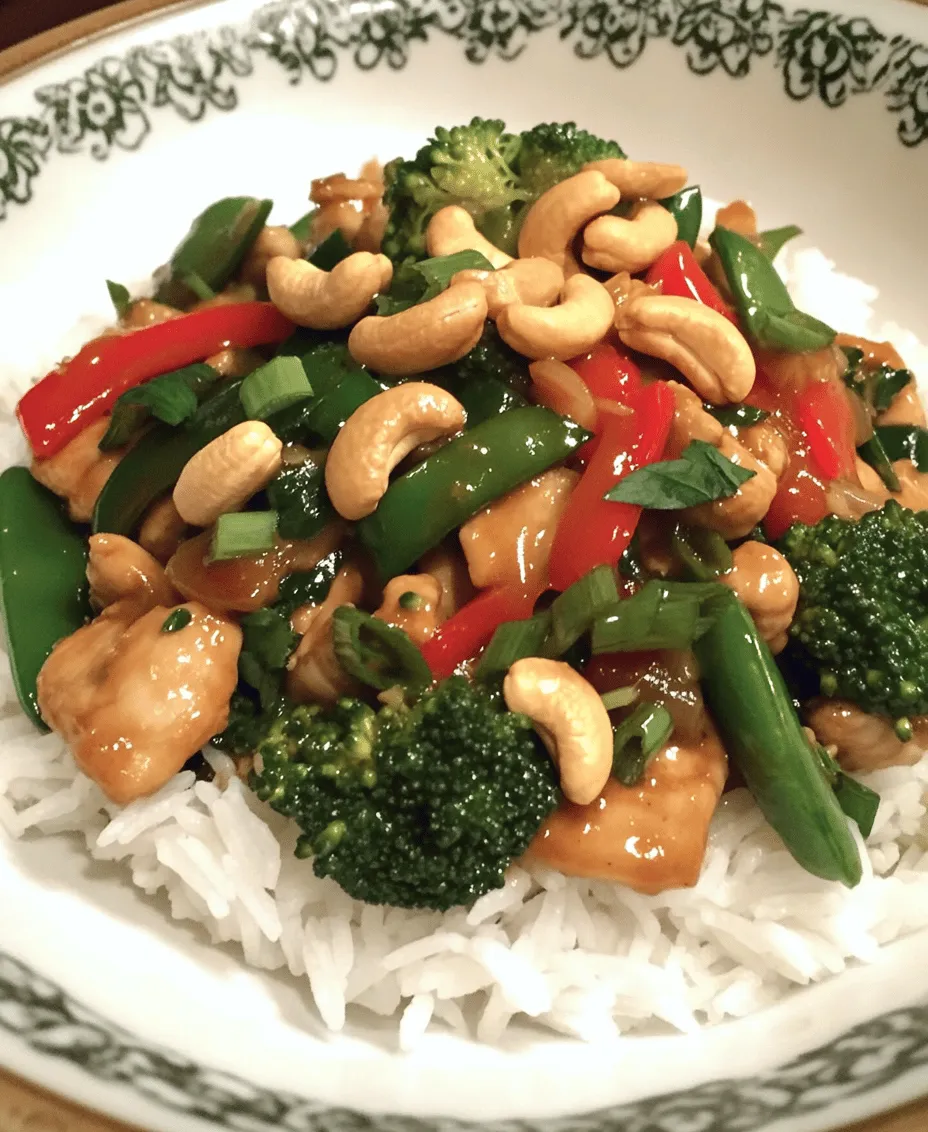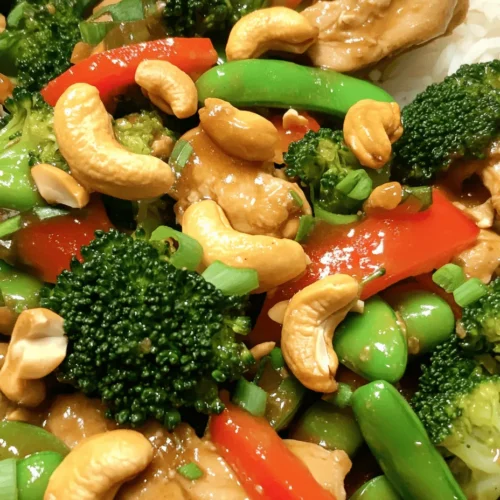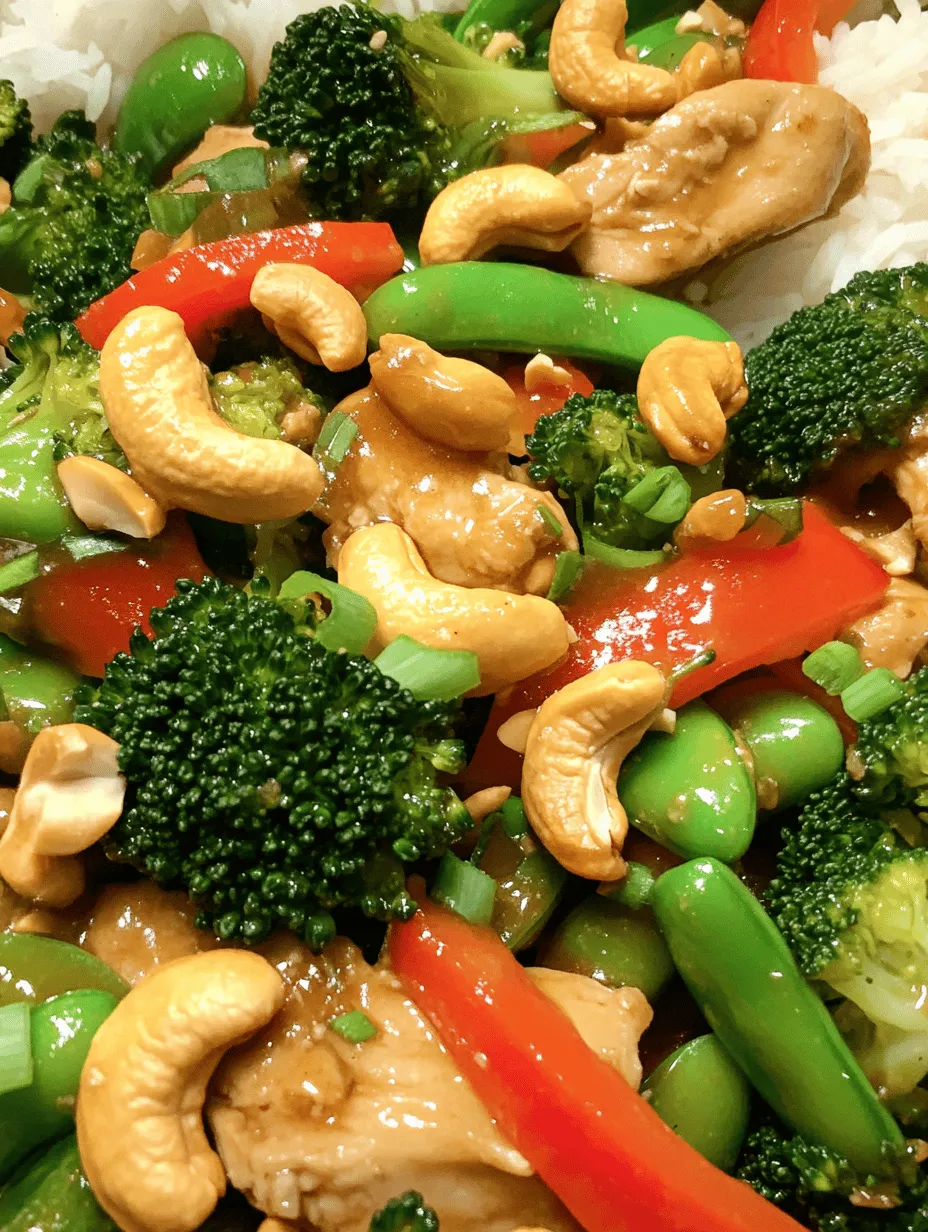In recent years, the popularity of takeout meals has skyrocketed, providing a quick and convenient option for busy individuals and families. However, as people become more health-conscious, there is a growing desire for homemade alternatives that not only satisfy cravings but also prioritize nutrition. Enter the Better-Than-Takeout Cashew Chicken recipe—a mouthwatering dish that combines the convenience of a takeout favorite with the benefits of wholesome, fresh ingredients.
This Better-Than-Takeout Cashew Chicken is not just about flavor; it’s a healthier, homemade option that you can whip up in no time. Packed with protein, healthy fats, and vibrant vegetables, this dish is perfect for anyone looking to enjoy a delicious meal without the guilt associated with traditional takeout. With its quick preparation time, it’s ideal for those with busy lifestyles who still want to enjoy a satisfying and nutritious dinner.
What Makes This Cashew Chicken Better Than Takeout?
One of the primary concerns with takeout meals is the nutritional content, which often includes high levels of sodium, unhealthy fats, and added sugars. The Better-Than-Takeout Cashew Chicken addresses these concerns by offering a healthier version that showcases the benefits of cooking at home. When you make this dish, you can control the ingredients, ensuring that you use whole foods that provide essential nutrients.
Health Benefits Compared to Traditional Takeout
– Reduced Sodium: Most takeout meals are loaded with sodium, which can contribute to high blood pressure and other health issues. By preparing this dish at home, you can use low-sodium soy sauce and control the salt levels to suit your dietary needs.
– Whole Ingredients: This recipe emphasizes the use of whole, fresh ingredients rather than processed components. This not only enhances the nutritional profile but also elevates the flavors of the dish.
– Customization Options: One of the best parts of making cashew chicken at home is the ability to customize it to your preferences. Whether you want to add extra vegetables, substitute chicken with tofu, or adjust the spices, the choice is yours. This flexibility allows you to cater to your family’s tastes and dietary restrictions.
The Satisfaction of Cooking at Home
There’s an undeniable satisfaction that comes from cooking your own meals. Not only do you have control over what goes into your food, but you also get to enjoy the fresh flavors that come from using quality ingredients. The aroma of garlic and ginger wafting through your kitchen as you prepare this dish is sure to evoke a sense of comfort and warmth, making it a delightful experience from start to finish.
Ingredients Breakdown
To achieve the best flavors and nutritional benefits in your Better-Than-Takeout Cashew Chicken, it’s essential to use high-quality ingredients. Let’s take a closer look at the key components that make this dish shine.
Chicken
Chicken is the star of this dish, providing lean protein that is vital for muscle growth and repair. When selecting chicken for your cashew chicken, opt for boneless, skinless chicken breasts or thighs. Breasts are lower in fat, while thighs offer a richer flavor. Regardless of your choice, look for organic or free-range options if possible, as these tend to have a better flavor and nutritional profile.
Cashews
Cashews add a delightful crunch and creamy texture to this dish. They are also a great source of healthy fats, protein, and essential minerals like magnesium and zinc. When purchasing cashews, look for unsalted varieties to avoid adding unnecessary sodium to your meal. Store them in an airtight container in a cool, dry place to maintain their freshness.
Vegetables: Broccoli, Bell Pepper, Snap Peas
Incorporating a variety of vegetables into your cashew chicken not only boosts its nutritional value but also adds color and flavor.
– Broccoli: This powerhouse vegetable is rich in vitamins C and K, fiber, and antioxidants. It offers a crunchy texture that complements the tender chicken and creamy cashews.
– Bell Pepper: Available in various colors, bell peppers are high in vitamin C and add a sweet, crunchy element to the dish. They also provide a vibrant visual appeal, making your meal more enticing.
– Snap Peas: These crisp, sweet peas are not only delicious but also a great source of vitamins A and C, as well as fiber. Their bright green color enhances the overall presentation of the dish.
Aromatics: Garlic and Ginger
Garlic and ginger are essential aromatics that elevate the flavor profile of your cashew chicken. Garlic provides a savory depth, while ginger adds a warm, spicy note that pairs beautifully with the other ingredients. Together, they create a fragrant base that enhances the overall dish.
Sauces
The flavor of your Better-Than-Takeout Cashew Chicken heavily relies on the sauces used. Traditional recipes often call for soy sauce and oyster sauce.
– Soy Sauce: This umami-rich sauce is a staple in Asian cuisine. For a healthier option, consider using low-sodium soy sauce to reduce your overall salt intake.
– Oyster Sauce: This sauce adds a unique depth of flavor and sweetness. If you have dietary restrictions, you may substitute it with mushroom sauce for a vegan alternative.
When preparing your cashew chicken, ensure that you select sauces that align with your dietary preferences, and always check for quality ingredients to maximize flavor.
Preparation Steps for Perfect Cashew Chicken
Now that we’ve explored the ingredients, let’s dive into the preparation process. Follow these step-by-step instructions to create a delicious Better-Than-Takeout Cashew Chicken that will impress your family or guests.
Step 1: Prepare the Chicken
Start by cutting your chicken into bite-sized pieces. This ensures that they cook evenly and absorb the flavors of the sauce. To achieve the best texture, coat the chicken pieces with a thin layer of cornstarch. This technique will help create a crispy outer layer when cooked, reminiscent of the takeout version. The cornstarch also aids in locking in moisture, keeping your chicken tender and juicy.
Step 2: Marinate the Chicken
For enhanced flavor, marinate the chicken pieces in a mixture of soy sauce, garlic, and ginger for at least 15 to 30 minutes. This step allows the chicken to soak up the aromatic flavors, ensuring that every bite is packed with taste. You can also add a teaspoon of sesame oil for an extra layer of richness.
Step 3: Prepare the Vegetables
While the chicken is marinating, wash and chop your vegetables. Cut the broccoli into florets, slice the bell peppers, and trim the ends of the snap peas. Having all your ingredients prepped and ready to go will streamline the cooking process and ensure that everything cooks evenly.
Step 4: Stir-Fry the Chicken
Heat a large skillet or wok over medium-high heat and add a tablespoon of oil (such as vegetable or peanut oil). Once the oil is hot, add the marinated chicken in a single layer. Allow it to sear without stirring for a couple of minutes to develop a golden-brown crust. Then stir-fry until the chicken is cooked through and no longer pink in the center.
Step 5: Add the Aromatics
Once the chicken is cooked, push it to one side of the skillet and add a bit more oil if needed. Add minced garlic and ginger to the empty side and sauté until fragrant. This step releases the essential oils from the garlic and ginger, infusing the dish with their aromatic properties.
Step 6: Incorporate the Vegetables
Next, add your prepared vegetables to the skillet. Stir-fry for a few minutes until the veggies are vibrant and tender-crisp. This method not only preserves their nutrients but also maintains their crunch, adding texture to every bite.
Step 7: Combine and Add Sauce
Finally, return the chicken to the skillet, and pour in the sauce mixture (including soy sauce and oyster sauce) over the chicken and vegetables. Toss everything together to ensure an even coating. Cook for an additional minute or two, allowing the sauce to thicken slightly and coat all the ingredients beautifully.
By following these simple steps, you’ll have a tantalizing Better-Than-Takeout Cashew Chicken that is not only delicious but also packed with nutritional goodness. This homemade dish is sure to become a regular feature in your weekly meal rotation, offering a satisfying alternative to traditional takeout options.

The Significance of Marinating the Chicken in the Sauce
Marinating the chicken in the sauce is an essential step that enhances the overall flavor of the dish. By allowing the chicken to soak in the marinade, the meat absorbs the savory and tangy notes of the sauce, resulting in a more flavorful and tender outcome. The acidity from ingredients like soy sauce and vinegar helps to break down the proteins in the chicken, making it juicy and delectable.
For best results, marinate the chicken for at least 30 minutes before cooking, though a few hours or even overnight would yield even better flavor. This step not only infuses the chicken with taste but also ensures that every bite is as delicious as the last.
Tips for Stir-Frying: Achieving the Right Temperature and Timing
Stir-frying is a quick and efficient cooking method, but it requires precision. To achieve that perfect stir-fry, ensure your wok or skillet is preheated before adding oil. A hot pan will create a searing effect that locks in moisture and flavor, preventing the chicken and vegetables from becoming soggy.
When adding ingredients, always start with the proteins, in this case, the marinated chicken. Sauté the chicken until it is browned and cooked through, which typically takes about 5-7 minutes. Remove the chicken and set it aside before adding the vegetables.
Timing is crucial; you want to add your veggies in a sequence that allows them to cook evenly. Softer vegetables such as bell peppers and snap peas should be added after the chicken has been removed, allowing them to cook for just a few minutes until they are tender-crisp. This technique ensures that they retain their crunch and vibrant color, contributing not just to the dish’s flavor but also its visual appeal.
Importance of Cooking Vegetables to Retain Their Crunch and Nutrients
Cooking vegetables correctly is just as important as cooking the chicken. Overcooking can lead to mushy vegetables that lose their vibrant colors and essential nutrients. Ideally, you want to stir-fry the vegetables until they are tender yet still crisp. This method preserves vitamins and minerals that can be lost through prolonged cooking.
Visual cues can help you judge when vegetables are done. Look for bright colors and a slight sheen. For instance, snap peas should be bright green and still snap when bitten into, while bell peppers should retain some firmness. This not only enhances the dish’s texture but also makes it more visually appealing.
Visual Cues to Look for at Each Step for Novice Cooks
For novice cooks, visual cues can provide reassurance that you’re on the right track. Here are some key indicators:
1. Chicken: When the marinated chicken turns golden brown and no longer appears pink inside, it’s cooked through. The meat should feel firm to the touch.
2. Vegetables: Look for vibrant colors and a slight sheen. Vegetables should be tender but still have a crunch. If they start to lose their color, they are likely overcooked.
3. Sauce: The sauce should be bubbling gently and thickening slightly as it coats the chicken and vegetables. If it appears too watery, let it simmer for a little longer.
Cooking Techniques Explained
Overview of Stir-Frying: History and Benefits of This Cooking Method
Stir-frying is a traditional Asian cooking technique that dates back thousands of years. Originating from China, this method involves cooking food quickly at high heat in a small amount of oil, often in a wok. The rapid cooking allows food to retain its natural flavor, color, and texture, making stir-fry a healthy cooking option.
One of the primary benefits of stir-frying is its efficiency. The high heat cooks food quickly while preserving nutrients, making it a go-to method for busy home cooks. Additionally, the technique allows for a variety of ingredients to be combined, creating complex flavors in a single dish.
Explanation of How to Properly Sauté Garlic and Ginger Without Burning
Garlic and ginger are essential ingredients in many Asian dishes, including our Better-Than-Takeout Cashew Chicken. However, they can easily become burnt if not handled correctly. To sauté them without burning, follow these steps:
1. Timing: Add garlic and ginger to the hot oil after the meat has been removed. This prevents them from cooking too long and turning bitter.
2. Heat Control: Keep the heat at medium to medium-high. If the oil begins to smoke, reduce the heat slightly.
3. Watching Closely: Stir frequently and watch for a fragrant aroma and slight browning, which typically takes about 30 seconds to 1 minute. Once they emit their scent, proceed to add the other ingredients.
Best Practices for Combining Ingredients for Maximum Flavor Distribution
To maximize flavor distribution in your Better-Than-Takeout Cashew Chicken, consider these best practices:
1. Layering Flavors: Start by sautéing aromatics like garlic and ginger before adding the chicken. This builds a flavor base.
2. Add Ingredients in Stages: Follow the sequence of cooking protein first, then vegetables, and finally the sauce. This allows each component to cook properly without overcrowding the pan.
3. Tossing: Use a spatula to toss the ingredients frequently. This ensures that every piece of chicken and vegetable is coated with the sauce, enhancing flavor throughout the dish.
Serving Suggestions and Pairings
Now that your Better-Than-Takeout Cashew Chicken is ready, it’s time to think about serving suggestions that will elevate your meal.
Ideas for Serving the Better-Than-Takeout Cashew Chicken
This dish is versatile and can be served in various styles. Here are some ideas:
1. With Cooked Rice or Quinoa: Serve the cashew chicken over a bed of steamed white or brown rice, or for a healthier alternative, try quinoa. Both options absorb the sauce well and balance the flavors.
2. Cauliflower Rice: For a low-carb option, serve with cauliflower rice. This not only complements the dish but also adds fiber and nutrients.
Suggestions for Garnishing
Garnishing your cashew chicken adds visual appeal and extra flavor. Consider these garnishes:
1. Fresh Herbs: Chopped cilantro or green onions can add a fresh note and bright color.
2. Lime Wedges: A squeeze of lime just before serving can enhance the flavors and add a zesty kick.
3. Additional Nuts: Sprinkle more cashews on top for added crunch and richness.
Tips for Meal Prep and Storage
If you enjoy meal prepping, this dish is perfect for making in advance. Here are some tips to keep leftovers fresh:
1. Storage: Store leftover cashew chicken in an airtight container in the refrigerator for up to 3-4 days. Reheat in the microwave or on the stove while adding a splash of water to prevent dryness.
2. Freezing: You can freeze the cooked chicken and vegetables for up to 3 months. Thaw in the refrigerator overnight before reheating.
Nutritional Information
Understanding the nutritional content of your meals is crucial for maintaining a balanced diet. Here’s a breakdown of the nutritional content per serving of Better-Than-Takeout Cashew Chicken:
– Calories: Approximately 350 calories
– Protein: 30 grams
– Fats: 15 grams (mostly from healthy nuts)
– Carbohydrates: 30 grams
This dish is a healthier alternative compared to typical takeout options, which can often be higher in calories, unhealthy fats, and sodium. By preparing this dish at home, you have control over the ingredients, allowing you to adjust seasoning and portion sizes to better fit your dietary needs.
Comparison to Typical Takeout Options in Terms of Nutrition
When considering takeout options, many dishes are laden with excessive oils, sugars, and sodium. In contrast, your homemade Better-Than-Takeout Cashew Chicken is a protein-rich meal that offers healthy fats from the cashews, fiber from the vegetables, and lower sodium levels due to the controlled use of soy sauce. This makes it a more nutritious choice that aligns with a balanced diet.
Conclusion
In conclusion, making Better-Than-Takeout Cashew Chicken at home is not only a delightful culinary experience but also a healthier lifestyle choice. The ability to marinate the chicken, control cooking techniques, and select fresh ingredients allows you to create a dish bursting with flavor and nutritional value.
Don’t hesitate to experiment with different vegetables or proteins to suit your taste preferences. Cooking at home brings joy and satisfaction, and it allows you to enjoy delicious meals without compromising on health. Embrace the art of cooking and savor the flavors of your homemade creations, knowing you are nourishing yourself and your loved ones with every bite.


